Saturday, Feb 20, 2016
For hundreds of years wolves that pose a threat to livestock or property have been killed. As the United States expanded west, efforts to eradicate the species from the North American continent were institutionalized. They worked. By the late 1950s, the native gray wolf was all but extinct in the lower 48 with the exception of a small population in northern most Minnesota. Conservationists intervened and, slowly but surely, populations recovered. Today, as packs regain territory around the Great Lakes and states west of the Rockies, they’re once again running into herds of cattle.
Hoping to counter the kill ‘em all mindset of past centuries with alternatives that work, Defenders of Wildlife—the national, non-profit conservation organization—has released an updated version of its 2008 manual Livestock and Wolves: A Guide to Nonlethal Tools and Methods to Reduce Conflicts. This 2nd edition builds on the now decade old collaboration between wildlife conservationists, biologists, agency specialists and ranchers operating in wolf territory with the intention of helping livestock producers “best address the root cause of wolf depredation in economical ways that protect both livestock and wildlife.”
The manual, which can viewed in its entirety here, is broken down into eight sections designed to provide ranchers with the resources they need to minimize their interaction with wolves and, when packs pose a threat to their business, implement nonlethal solutions.
Assessing Your Needs
Terrain and conditions vary by region and the manual suggests, “Deciding which tools, methods and strategies are suitable for protecting your livestock depends on many different factors.” The right alternative to lethal measures is not a one size fits all proposition. In addition to providing some low and high-tech considerations, the manual includes a directory of the state and federal agencies available for assistance in wolf country.Here are the Cliff Notes:
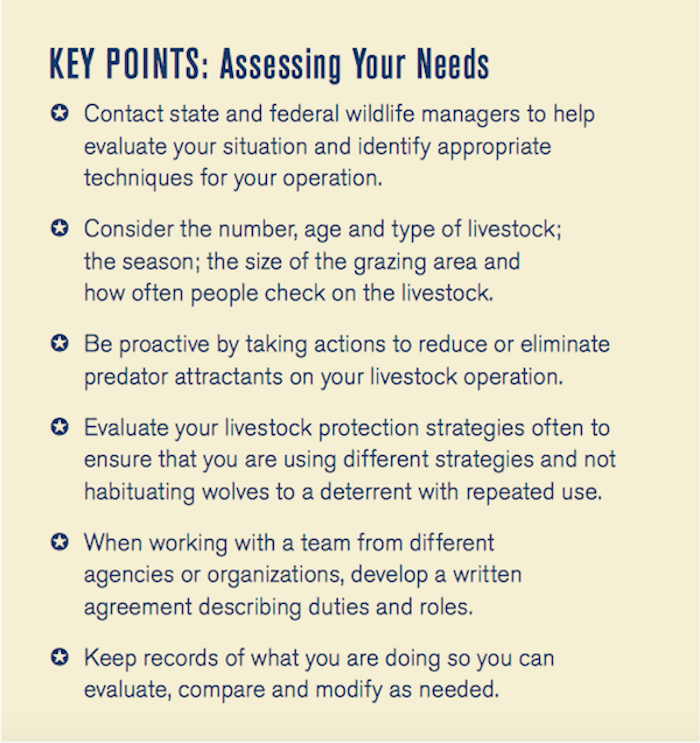
Reducing Attractants
While acknowledging it’s not always possible, the manual insists that a proactive approach—taking steps to prevent your livestock operation from attracting wolves in the first place—is often the best strategy. In addition to being skilled hunters, wolves are opportunistic scavengers and attracted to the scent of sick or already dead food sources. Therefore quickly removing carcasses, or relocating them away from homes and areas used by the healthy herd can go a long way in reducing a pattern of conflict.“Once animals that are both scavengers and hunters—such as wolves, bears and eagles—are drawn to an area, the likelihood increases that they will go from feeding on a carcass to hunting and killing live cattle or sheep nearby.”
Because once wolves become accustomed to a food source, the chances are good that they will return in hopes of an easy meal. In the absence of a rendering facility or carcass-composting site “carcass pits”—holes used to contain dead livestock in a designated area, which can then be enclosed with fencing—can be beneficial.
“In northeastern Oregon, biologists discovered livestock carcass pits using only satellite data from radio-collared wolves that showed frequent visits to the sites of the pits. Once producers removed the pits, the wolves lost interest and eventually stopped visiting these sites.”
The manual also explains “the afterbirth from calving can be a powerful attractant for wolves, a fact to consider when planning the timing and location of calving activities.”
Working with Livestock Guardian Dogs
Though it’s widely understood that modern dogs are the direct descendants of gray wolves, recent studies suggest it’s possible the two shared a common, now extinct ancestor and diverged 11,000-16,000 years ago. While this throws a wrench in the notion that the domestication of dogs began with a few less aggressive gray wolves hanging around in our hunting and gathering days, there is still much to learn. Regardless, dogs have lived alongside livestock for centuries and today the practice of breeding dogs to protect cattle from predators is a science in its own right.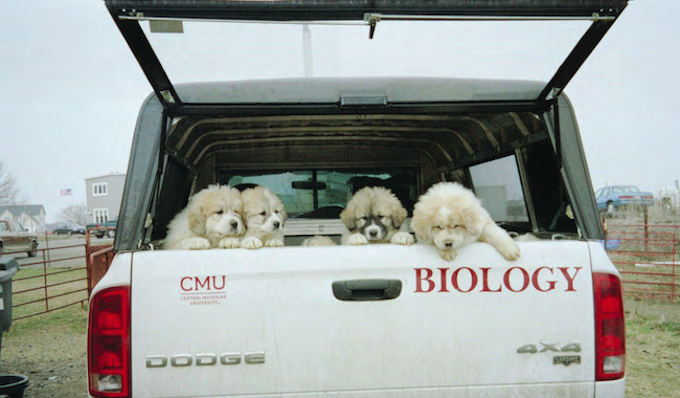
Great Pyrenees pups are ready for transport to farms in the Great Lakes region where researchers will monitor their effectiveness at protecting livestock from predators. (Photo/Caption: Anna Celler / Defenders of Wildlife)
Carefully bred, selected and trained Livestock Guardian Dogs (LGDs) may greatly reduce the number of reported conflicts when used. In fact, the manual states, often their mere presence can help keep wolves away. Dogs can also play an important role in alerting herders to the presence of predators. In some cases, this advanced warning may allow ranchers to take the steps necessary to prevent livestock and wolf fatalities. Generations of selective breeding to emphasize useful traits has left some breeds better suited than others, but not all dogs are built for the job.
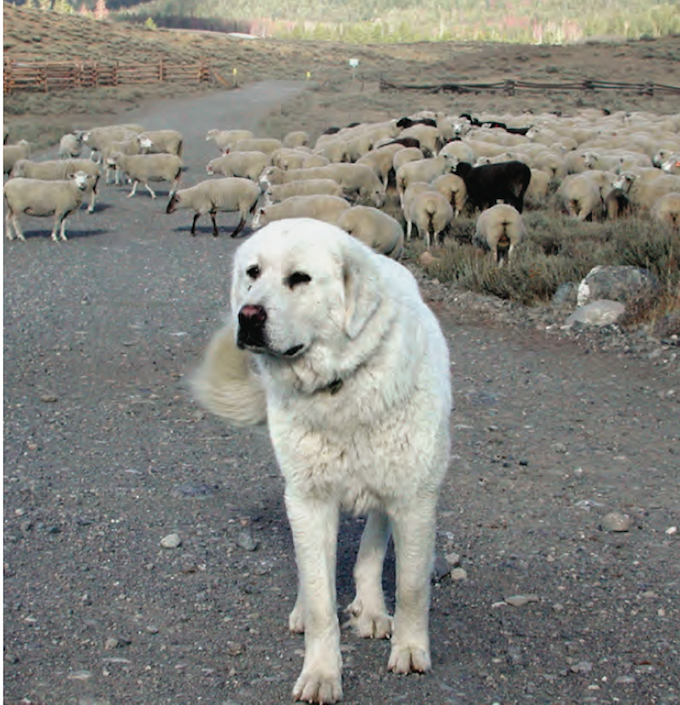
A Great Pyrenees stands guard on an Idaho sheep ranch. (Photo/Caption: Brad Devries / Defenders of Wildlife)
“The ability of a livestock guardian dog (LGD) to protect livestock is partly a result of genetics and careful breeding and partly a result of socialization and proper training. Over the centuries, people have selected the best working dogs for breeding purposes to pass along valuable traits to future generations. Dogs that harassed or harmed livestock were typically relieved of duty and not permitted to breed, thereby removing undesirable traits from the gene pool. Socializing and bonding pups with livestock is a crucial part of their training. The climate and landscape in which the dogs live, the distances they travel, the diseases they are exposed to and their food supply also influence their behavior.”But selecting the right temperament and characteristics in a working dog is not always intuitive:
“Breeds that make good LGDs are not the same breeds that make good livestock herders. The two functions, guarding and herding, are quite different, and the dogs that do best at each task have been bred for their specific tasks. In other words, border collies are bred to herd; Great Pyrenees are bred to guard."Careful selection, furthermore, is not just a matter of breeding:
“Regardless of breed, selecting your pups from good working stock and similar livestock operations is important. Pups learn from their mothers, so make sure she has the characteristics of a good LGD. Base your selection on a dog’s working potential, rather than breed registration and physical standards. Pups can learn behavior, but not all registered LGD breeds are born with the instincts necessary to do well. The right LGD is the one that demonstrates the traits necessary for your particular situation. Desirable LGDs reliably stay with their livestock and successfully defend them by alerting people to the presence of threatening predators.”
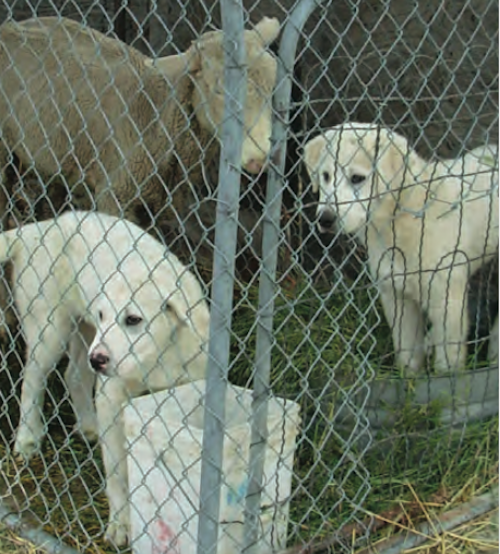
Erecting Barriers: Fencing, Fladry and Penning
The cost, utility and effectiveness of fences vary, as do the types of barriers themselves. Permanent fencing can be a very effective predator deterrent in smaller pastures but is not always feasible for larger operations—including those that rely on pubic lands, where the mobility of other wildlife must be taken into consideration. Fladry, a barrier that consists of colorful flags or pendants hung along a thin rope at regular intervals, is a relatively inexpensive method that's shown some promise in deterring wolves from crossing into the land they enclose. Over time, however, they can lose their effectiveness. As wolves get used to the sight of the flags, they inevitably drum up the courage to step through them.To be effective, it is important to install the fladry properly. Researchers used red or orange reinforced plastic flags measuring 50.8 centimeters by 10 centimeters (approximately 20 inches by four inches) sewn at 50.8-centimeter (20-inch) intervals on a 0.2-centimeter (0.8 inch) diameter nylon rope suspended so that flags hang 50.8 centimeters (20 inches) above the ground on secure posts spaced roughly 30 meters (98 feet) apart. Depending on the type of materials used, fladry may require regular maintenance to keep it from coiling around itself or the rope, dropping too low or hanging too high. Cattle are also known to chew and pull on fladry. A broken, frayed, tangled, pinned down or otherwise compromised fladry will not deter predators and must be replaced. Properly designed fladry and turbofladry can be difficult to find commercially. Contact your local wildlife or agriculture agency.
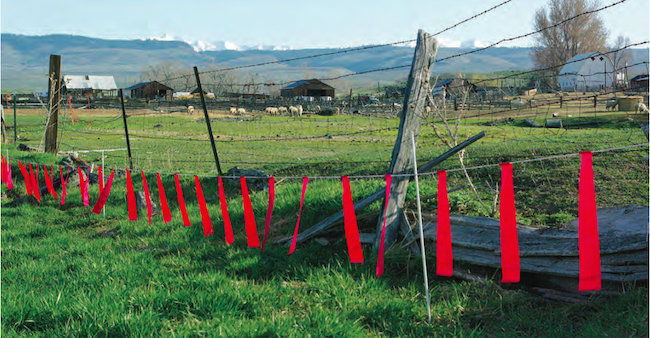
Turbofladry, fladry hung along electrified fencing, adds the element of shock, boosting the effectiveness of the fladry barrier. (Photo/Caption: Oregon Department of Fish and Wildlife / Defenders of Wildlife)
Portable fences can be made from several different types of materials including multiple electric fencing strands, wire netting or mesh, and portable panels. The cost, utility and effectiveness vary based on the type and number of livestock and the terrain. To help reduce livestock stress, get your animals accustomed to the portable pens by using them during feeding times, etc. If you have a grazing allotment, make sure your grazing permit allows the use of portable fencing. You should also regularly move the fencing to keep native plants from being trampled or overgrazed.
Increasing Human Presence: Range Riders and Herders
Fact: Wolves often attack livestock when no one is looking. With this in mind, the manual points out that an increased human presence—whether it's riders patrolling the range or an increased number of herders watching over sheep—may be "one of the best ways to deter wolves.""A range rider, for example, can patrol your ranch or allotment at dawn and dusk when wolves are most active. The rider checks for signs of unusual agitation in the cattle, behavior that can indicate wolves or other predators are in the area. The rider also listens for howling and looks for other signs that wolves are present such as tracks, scat and hair snagged in fences. Rider protocols vary from place to place, but the underlying concept is similar: Regular or frequent human presence can minimize livestock loss to wolves that avoid contact with humans or by intervening when wolves attempt to prey on livestock. In the best scenarios, riders who are able to respond quickly to wolves approaching or chasing livestock can prevent losses from occurring simply by their presence."
"Riders and herders can monitor livestock closely, providing other advantages such as finding dead livestock and identifying cause of death and providing early detection of injury, illness or stress in the herd. Riders can also assist with preventing livestock from overgrazing sensitive meadows and streambeds, reducing the chances of livestock theft and detecting the presence of plants toxic to livestock. Adding this kind of personnel increases production costs for the livestock operation but may be worth the cost if losses to predators and other threats are minimized. Finding experienced riders and herders can be difficult because wages are often low and the work is hard, especially when it involves nighttime surveillance and camping with livestock. Agencies, conservation groups and other ranchers may be able to help by pooling resources for range riders, adding herders and providing other preventative measures."
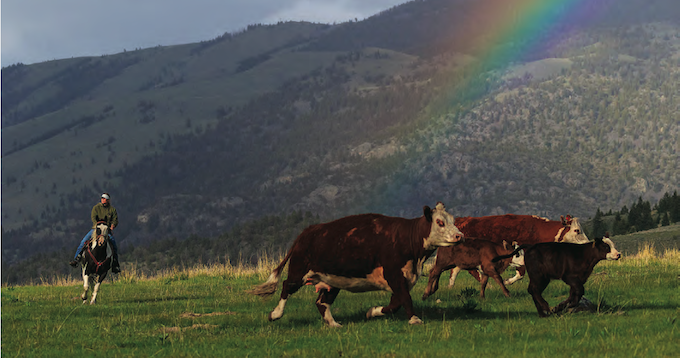
A range rider monitors a herd. (Photo: Ronan Donovan)
Using Scare Tools and Tactics: Alarms, Lights and Nonlethal Ammunition
Nonlethal methods to deter wolves are constantly evolving and the options available to livestock owners have come along way from the days of banging a wooden spoon on a metal pot (still a last minute classic). Scare devices such as air horns, starter pistols and high beam flashlights are both inexpensive and proven performers. Automated light systems and radio-activated alarms—RAG boxes for short—are another option."RAG boxes consist of a receiver, a bright strobe light, two loudspeakers and an internal computer that collects and stores information received from transmitters on wolves’ radio collars. To keep wolves from getting used to any one sound, RAG boxes produce a variety of alternating sounds, which can range from sirens to gunshots to beating helicopter blades to cowboys yelling on horseback. The RAG box can be attached to a fence line or placed nearby and set to go off whenever it picks up a preprogrammed radio-collar signal (it only works on radio-collared animals). Power is supplied to the RAG box either through a 12-volt car battery, which needs to be charged every couple of weeks, or through a solar panel that recharges itself. Studies by Wildlife Services and the University of Nebraska found that RAG boxes are most effective for small pastures (60 acres or less), especially when lambing or calving is taking place in smaller enclosures."
Of course:
Because nonlethal ammunition can inflict serious injuries if used improperly, it is important to learn how to use it and to understand the specific conditions under which the various types can be safely and legally used. In some areas these tools are prohibited or require a permit.
Switching Grazing Sites and Other Methods Worth Considering
Relocating a grazing operation is no doubt a tough sell for any livestock owner, but according to this report "some wildlife conservation groups or land trusts have purchased grazing permits from livestock owners on a voluntary basis to end chronic conflict and lethal wolf and grizzly control." When successful, these arrangements allow ranchers to purchase new permits in areas less prone to conflict.“Cooperative agreements to temporarily switch or permanently retire grazing allotments can help reduce livestock-predator conflicts and provide benefits to other wildlife species such as elk and deer. There are many examples of ranchers, conservationists and agency officials successfully working together to adjust the timing and location of allotments to minimize conflicts with wildlife and allow livestock grazing activities to continue. In some cases of permanent grazing allotment retirement, willing ranchers have received payment for the value of their public grazing permits in high-conflict areas and then used the funds to lease or purchase new pastures in other areas where losses from predators were less likely.”In addition to scientifically researched methods, the report also includes promising but unverified approaches to predator conflict management being used by participating livestock operations in different countries. One such area for further study suggests "mountain-savvy" cows—heifers with experience being around wolves—are better at defending their young than their "naive" counterparts.
"Ranch managers in southwestern Alberta have noticed that cows familiar with wolves are less vulnerable to depredations than cows outside of wolf territories. Similarly, ranchers who regularly transported naïve, pregnant cows from prairie pastures to the rugged mountains of Gila National Forest in New Mexico reported high rates of livestock losses. In these instances, the cow’s unfamiliarity with wolves or the new landscape and lack of maternal experience likely contributed to high calf mortality as opportunistic wolves moved in quickly to take advantage of the situation. More and more, ranchers in the western United States are reporting witnessing mother cattle successfully defending their calves from wolves."For other approaches to livestock management that may warrant further exploration—from whether or not your cows should wear bells to group calving strategies—have a look at the full report.

In 2008, Ian Whalan, an Australian sheep and cattle
farmer, invented Foxlights to address his country’s serious problem of
fox predation on newborn lambs. In 2013, Defenders’ nonlethal wolf
control expert visited an Australian project that was using the lights
to deter dingoes and brought a shipment of the devices back to the
United States. Since then, Foxlights have been successfully used to keep
wolves away from livestock in Idaho, Montana, Oregon, Washington and
Wyoming. (Photo/Caption: Defenders of Wildlife)
source
source


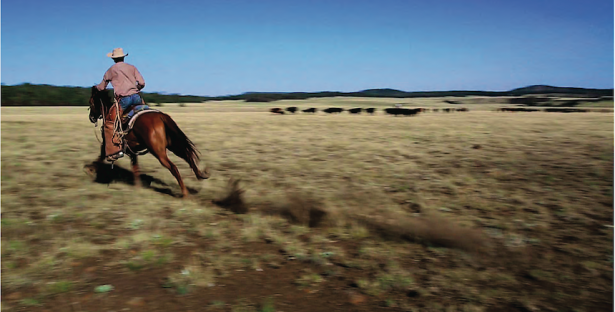
No comments:
Post a Comment